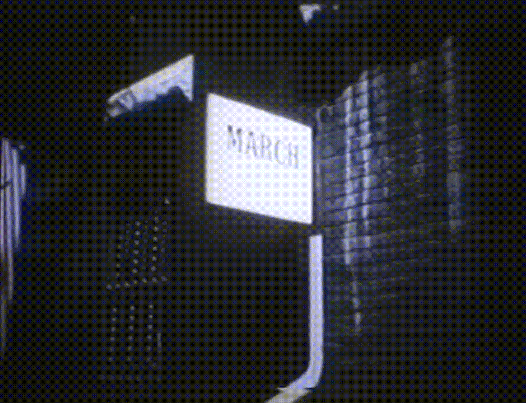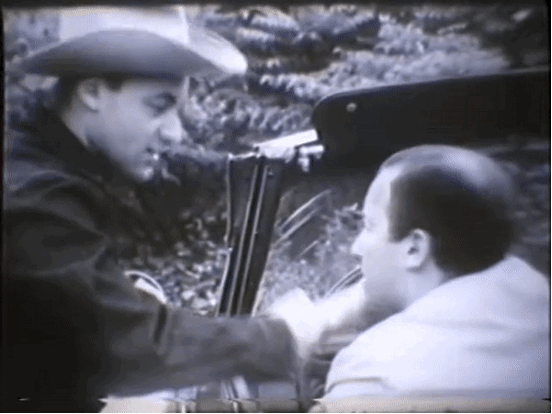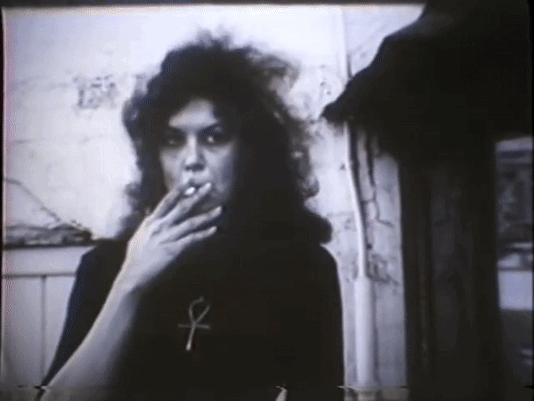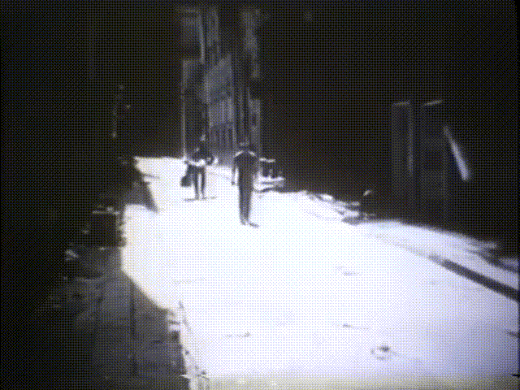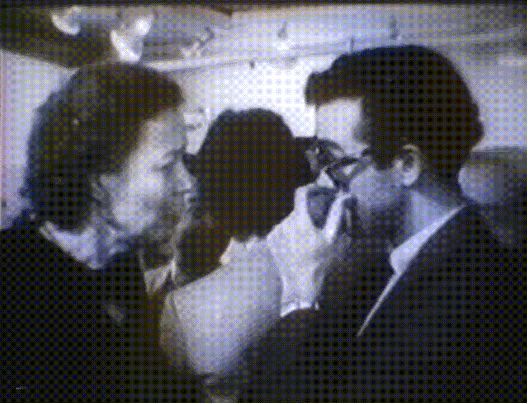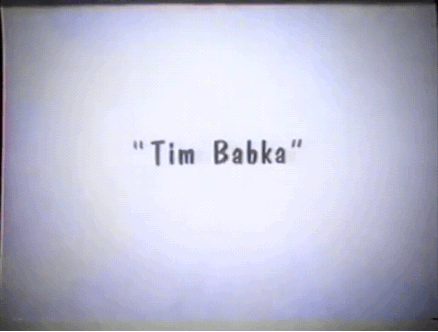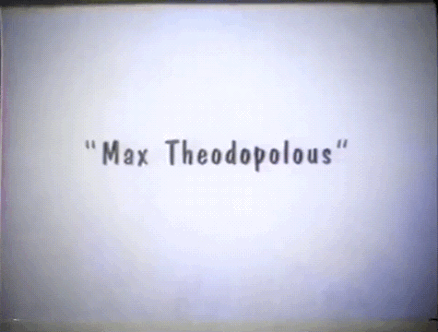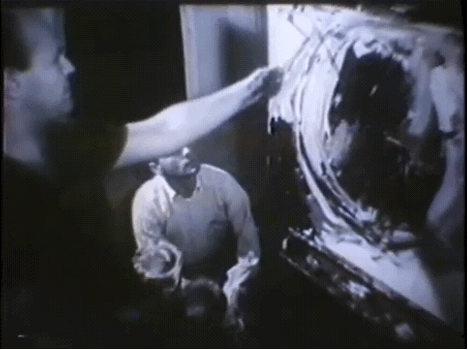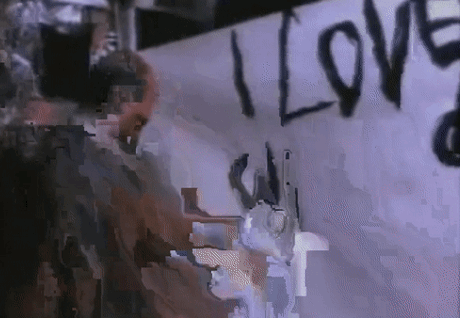A Bowl of Cherries: Footage of a Forgotten Happening
/The following post was created as part of the assigned work for Henry Jenkins's PhD seminar, Public Intellectuals. The goal of the class is to help communication and media studies students to develop the skills and conceptual framework necessary to do more public-facing work. They learn how to write op-eds, blog posts, interviews, podcasts, and dialogic writing and consider examples of contemporary and historic public intellectuals from around the world. The definition of public intellectuals goes beyond a celebrity-focus approach to think about all of the work which gets done to engage publics — at all scales — with scholarship and critiques concerning the media, politics, and everyday life. Our assumption is that most scholars and many nonscholars do work which informs the public sphere, whether it is speaking on national television or to a local PTA meeting.
“Life is just a bowl of cherries/
So live and laugh at it all. ”
The satirical featurette A Bowl of Cherries (1961, dir. William Kronick) tells the story of a starry-eyed cowboy, named Sherman Williams, who moves to Greenwich Village with hopes of becoming America’s next great painter. It features prominent cameos by Jim Dine, Robert Whitman, and Lucas Samaras — three major pioneers of the downtown "Happening” scene. These artists introduce our protagonist to the prevailing style of “action painting,” made famous by Jackson Pollock and other Abstract Expressionists, forever altering his worldview. By the time A Bowl of Cherries hit theaters, action painting was on the verge of decline — making it a suitable subject of parody for artworld insiders witnessing these changes in real time.
figure 1: William Glover (AP), “Experimenting Film Director Swings Back into 'Silent'," The Amarillo Globe-Times, March 16, 1961, 20.
As active participants in “Painter’s Theater,” a process-oriented mode of performance art that flourished in the cooperative gallery spaces on Tenth Street in the early 1960s, Dine, Whitman, and Samaras were all experienced actors prior to making of A Bowl of Cherries. These semi-scripted, absurdist shows were staged in elaborate installations cobbled together from everyday objects, urban detritus, and expressionist paintings. Dine mused that the older generation of painters “Would have been embarrassed,” by these self-deprecating and delightfully nonsensical plays: “They would’ve said, ‘This isn’t serious. We are not actors. We are serious intellectuals. We are not circus performers.’” Creators of Painter’s Theater used comedy to puncture the self-seriousness of the prior generation, and to make dead-serious points about the role of art in a culture progressively geared towards mass-spectatorship. Much like Painter’s Theater, A Bowl of Cherries grapples with the legacy of action painting, asking what does art look like after Pollock? And, more existentially, what does an artist look like in a media landscape increasingly fascinated with the New York art world?
After reaching out to the film’s director and writer William Kronick via the comments section on YouTube, I had the opportunity to interview him on the phone on November 23, 2021.
Figure 2: Reaching out to William Kronick via YouTube.
Kronick told me he was inspired to make a film about the downtown art scene sometime in 1959 after reconnecting with his former college roommate, Bruce Glaser, the manager of Camino Gallery (one of several artist-run spaces on Tenth Street). At the time Glaser was dating Natalie Edgar, a painter and critic for ARTnews, who passed the script on to her brother George. A hotshot Wall Street investor keen on getting into the movie making business, George Edgar gave Kronick around $8,000 to make the picture no strings attached. With Glaser as his production coordinator and casting director, Kronick shot the entire film on location in Greenwich Village during a period of about twelve days in September 1960.
According to Kronick, the decision to cast working artists was financially motivated — as it was a vastly cheaper alternative to hiring professional actors. But as a stylistic choice, the casting is in keeping with a larger cultural shift in independent filmmaking towards realism and improvisation. Critic and filmmaker Jonas Mekas identified a new wave of American cinema “intimately linked with the general feeling in other areas of life and art: with the ardor for rock and roll; the interest in Zen Buddhism; the development of abstract expressionism (action painting); the emergence of spontaneous prose and New Poetry — all a long-delayed reaction against puritanism and the mechanization of life.”[1] Mekas points to Pull My Daisy (1959), directed by the photographer Robert Frank and painter Albert Leslie, as an example. Based on a play by Jack Kerouac (who also provides the film’s narration), this short chronicles a dinner party hosted by a railway brakeman and his wife, an abstract painter, featuring a star-studded cast of literary and artistic luminaries including Allan Ginsberg, Peter Orlovsky, Alice Neel, and Larry Rivers. "Pull My Daisy is an accumulation rather than a selection of images. It was made by non-professionals in search of that freer vision.”[2] In 1968 Leslie revealed that the film was in fact not improvised, but thoroughly rehearsed and scripted.[3] Pull My Daisy was successful (at least in part) because people believed the film to be improvised and thus truer to life.
Shot just two years after Pull My Daisy, A Bowl of Cherries operates under a similar fusion of reality and fiction. While the participating artists were not as famous as Ginsberg or Kerouac, they were nonetheless recognizable as “rising stars” in the New York artworld. Their presence in A Bowl of Cherries lends an air of authenticity to the project, enhanced by the film’s reliance on on-location scenery. At times the movie feels like a time capsule of 1960s New York, particularly in its documentation of now-defunct artists co-ops on Tenth Street, as the protagonist wanders through the actual, moving cityscape of Greenwich Village. However, the authenticity of the scene is doubly ruptured by the character’s ridiculous cowboy get-up and the flickering frame rate associated of a turn-of-the-century silent film.
figure 3: Fred McDarrah, View of Tenth Street Galleries, c. 1960
figure 4: View of Tenth Street Galleries from A Bowl of Cherries.
By toying with the aesthetic conventions of an old slapstick comedy, A Bowl of Cherries presents a proximate simulation of the downtown art scene primed for humorous critique. In a promotional interview for the film Kronick stated, “The fact that the actors can't talk, and the motion is unnatural creates a new reality.”[4] In keeping with the genre, the director substituted speech with old-fashioned title cards, which provide context for the pantomimed performances on screen. After reviewing a copy of the original script almost sixty years after the film’s production, Kronick remarked, “I couldn't believe it — I'm reading it and it's exactly the film that we shot. No changes…the title cards were all the same, identical.” From his recollection, the actors received the title cards prior to filming and used them as prompts for improvised action as the camera rolled. The title cards almost never line up with the mimed dialogue on screen, creating an odd dissonance between word and image.
The movie opens as a wannabe painter from the country, with the on-the-nose name Sherman Williams, is dropped off by a man in a convertible on the side of the West Side Highway. The driver is played by Kronick himself.
figure 5: Sherman Williams on the West Side Highway, with director William Kronick.
With several rolled-up canvases in hand, Williams dodges oncoming traffic in efforts to make it to the subway station, where he takes the train down to Christopher Street. Upon his arrival downtown he happens upon a group of stylish young women clad in all black, smoking cigarettes in front of Paperback Gallery (a literary hotspot in the Village). When Williams asks them where he can rent an artist’s studio they stare at him with skepticism, followed by a title card that reads: “Man, are you real?”
Figure 6: Sylvia Rudolph, Natalie Edgar, and Hilda Ruiz outside Paperback Book Gallery.
Getting the message, the cowboy backs away from the group of women and continues his downtown odyssey. After wandering around the Village, he stumbles upon the storefront of a laundromat advertising studio space for rent. The proprietor, played by painter James Hiroshi Suzuki, leads Williams through rubble-filled alleyways to get to a vacant loft.
figure 7: James Hiroshi Suzuki leading Sherman Williams to his new studio.
The space, according to Kronick, “was an actual downtown loft…about five blocks away [from the Tenth Street galleries]”. In the film, Williams hands over his life savings to the landlord and begins to hang his artwork up on the blank studio walls. As the cowboy unfurls his canvases, it is revealed to the audience that all of Williams’ paintings feature horses. Could there be a subject more out of step with fashionable New York?
figure 8: Sherman Williams and his horse painting.
After settling into the city, the protagonist finally goes to an art gallery in search of representation. As he walks into the space, he is confronted with abstract painting for the very first time, amounting to what can only be described as a revelatory experience.
figure 9: Sherman Williams encounters abstract art, and gallerist Bruce Glaser.
figure 10: Sherman Williams encounters abstract art, and gallerist Bruce Glaser.
Like Dorothy’s arrival in Oz, the film suddenly switches from black and white to color for a twenty-second interlude. Close-up shots of paintings are juxtaposed with images of Williams’ face, which switches from shock to suspicion, and ultimately satisfaction. Moving back to black and white, the cowboy shows his work to the gallery owner —played by Bruce Glaser. Unimpressed by the horse paintings, the gallerist nonetheless invites Williams to an art opening the following night.
This is where his true initiation into the art world occurs. Kronick shot this scene at an actual opening hosted at Great Jones Gallery, in celebration of a new show of paintings by Vivian Springford. Exhibition ephemera from the painter’s archive inadvertently reveals the filming date of this scene — September 26, 1960 —providing a more precise timeframe for the production of A Bowl of Cherries.
Figure 12: Vivian Springford in A Bowl of Cherries; exhibition ephemera from her exhibition, September 20, 1960.
Springford’s show was curated by critic Harold Rosenberg, one of the most influential proponents of action painting. Rosenberg most likely attended the party, and perhaps even passes by Kronick’s camera (although this is difficult to confirm visually). In the press release for Springford’s exhibition, Rosenberg writes: "a good number of people suspect that all it takes to be a modern painter is a beard, some canvas, and a good paint supply. Presumably, you do not even need a brush to paint abstraction. The reverse is true of Vivian Springford,” — a soak-stain painter in the vein of Helen Frankenthaler or Morris Louis.[5] Springford’s effusive, almost calligraphic paintings float in the background as Jim Dine, Robert Whitman, and Lucas Samaras are introduced on screen for the very first time, under the respective aliases of Benno Moskowitz, Tim Babka, and Max Theodopolous.
Figure 13: Robert Whitman as Tim Babka, Lucas Samaras as Max Theodopolus, and Jim Dine as Benno Moskowitz.
Figure 14: Robert Whitman as Tim Babka, Lucas Samaras as Max Theodopolus, and Jim Dine as Benno Moskowitz.
Figure 15: Robert Whitman as Tim Babka, Lucas Samaras as Max Theodopolus, and Jim Dine as Benno Moskowitz.
In the following scenes they proceed to school Williams in the various modes of abstraction. Samaras applies globs of paint to pieces of newsprint splayed out on the floor, and feverishly insists to the protagonist that “sensuous forms are the only ones to consider.” Whitman constructs a precariously hanging assemblage that almost hits Williams as it spins haphazardly around the room. Dine dips his hands directly into a can of white paint and uses his fingers as a brush. Maintaining a straight face, he reaches his paint-covered hand out towards Williams to say, “the tactile element in my work is wonderful.” Kronick stated that all the works featured on screen were made by the cast — although he did not recall what happened to these pieces after the end of the production, or if the artists considered these objects as a part of their oeuvre.
Figure 16: Sherman Williams gets a lesson in abstraction.
Figure 17: Sherman Williams gets a lesson in abstraction.
Figure 18: Sherman Williams gets a lesson in abstraction.
The idea of “performing” the artistic process for the camera is integral to discourse of action painting. Photojournalist Hans Namuth has been credited with with transforming Jackson Pollock “From a talented, cranky loner into the first media-driven superstar of American contemporary art, the jeans-clad, chain-smoking poster boy of abstract expressionism” through the medium of photography.[6] His widely circulated images of the artist at work depart from the long-standing convention of picturing the artist sitting stoically behind an easel.
figure 19: Jackson Pollock, by Hans Namuth, 1950.
Dine, in particular, was a voracious consumer of such heroic images of artists, stating in 1977: “As a college student, I schooled myself totally in the New York School, via ARTnews. I remember stealing bound volumes of ARTnews from the ’50s, tearing out pictures, and looking at de Kooning, Pollock, Kline, and everyone else from that period. I knew about everybody. It was an impressionable time for me. I was teaching myself about New York — the moves.” In his recollection Dine evokes something of the performative nature of these images (“the moves”) and suggests the importance of mediated images to his burgeoning art practice.
The Smiling Workman, one of Dine’s most important Painter’s Theater performances, is directly engaged with the legacy of Jackson Pollock. For this piece, Dine created then destroyed an abstract painting in front of a live audience, recreating a spectatorial experience in dialogue with Namuth’s photographs. The artist also decorated the set with white handprints, evocative of those left on Pollock’s canvases as traces of the artistic process.
Figure 20: Jim Dine in The Smiling Workman, photo by Martha Holmes, May 1960; Detail of Number 1A, by Jackson Pollock, 1948.
Figure 21: Jim Dine in The Smiling Workman, photo by Martha Holmes, May 1960; Detail of Number 1A, by Jackson Pollock, 1948.
Filmed six months after The Smiling Workman, Dine’s vignette in A Bowl of Cherries recreates aspects of this earlier work for the film camera. As in the performance, Dine presses his paint-covered hands into the canvas to show the protagonist an alternate mode of painterly expression, rooted in physical comedy.
After meeting with Dine, Williams soon becomes possessed with an almost manic drive to create new work. Wearing nothing but a pair of underwear and a bandana around his neck, Williams compulsively applies paint to both the canvas and his studio wall. He becomes so preoccupied with his work that he eventually loses his life savings and can only afford to feed his pregnant wife oatmeal.
figure 22: Sherman Williams tries abstraction.
As in A Bowl of Cherries, the danger of artistic obsession is also the subject of The Smiling Workman. Filmmaker Stan VanDerBeek shot a version of The Smiling Workman staged specifically for video (versus live performance). Not unlike A Bowl of Cherries, the film rendition of The Smiling Workman is a silent short — sped up to exaggerate Dine’s frenetic motion across the set. Overcome by mania, the artist hastily scrawls the words “I love what I’m doing” onto a piece of paper, before proceeding to pour a can of paint on his head and crash through the canvas.
Figure 23: Jim Dine in The Smiling Workman, film by Stan VanDerBeak, 1960.
Whereas Dine punches through the painting at the end of The Smiling Workman, A Bowl of Cherries concludes with Dine visiting Williams in his studio, only to slip and fall onto the cowboy’s unfinished canvas. His physical commitment to the scene is striking and demonstrates the artist’s interest in over-the-top slapstick comedy as a destabilizing force. Dine once remarked, “I do not think Smiling Workman was funny. I do not think obsession is funny or not being able to stop one’s intensity is funny.”[7] Despite the artist’s insistence that the performance was not intended to be comedic, he is nevertheless dressed as a clown.
Figure 24: Jim Dine falling onto Sherman Williams’s canvas.
In the early part of his career, Dine repeatedly played with different figurations of the clown character. For example, in The Big Laugh (a happening orchestrated by Allan Kaprow in which actors laughed at the audience for seven straight minutes), Dine played a carnival barker, donning white face paint and a straw hat. In Vaudeville Collage, staged at the Reuben Gallery on June 11, 1960, the artist created his approximation of a cabaret show. Appearing once again in clown makeup as the show’s MC, Dine attached vegetables to pieces of string and made them “dance” around the stage like marionette dolls. Dine was even known to attend gallery openings dressed up in a clown costume, blurring the boundary between life and art.
Figure 25: Jim Dine (in hat) in The Big Laugh, by Allan Kaprow, 1960.
Figure 26: Vaudeville Collage, June 11, 1960.
Figure 27: Jim Dine in clown makeup at gallery opening, c. 1960.
Figure 28: Jim Dine in clown makeup at gallery opening, c. 1960.
Discussing his creative partnership with Robert Whitman, Dine stated: “Because we had little children, we watched children's TV in the late '50s and early '60s and that said something about the kind of performances we made. We would refer to Captain Kangaroo…We listened to his way of speaking and the way the characters spoke. It put the performances out of the realm of literal theater by these characters for children speaking to them in this odd way, which wasn't naturalistic.”[8]
Figure 29: Bob Keeshan as Captain Kangaroo (L) and Clarabell the Clown (R).
Again, I find Dine’s reference to mass-media visuals incredibly fascinating. In performances such as Car Crash (1960), the artist did not act on a stage, but wandered freely through the audience — often pushing conventional boundaries of personal space. Although the painter scoffed at the suggestion that he was “the one who did the funny happenings,” laughter was an inevitable component of his outrageous and often uncomfortable performances. A photograph by Fred McDarrah, shows one such instance, in which critic Jill Johnson is pictured with her head tipped back in laughter as Dine (dressed in a Pierrot-inspired getup) lets out a guttural scream.
Figure 30: Jim Dine in Car Crash, November 1960. Photograph by Fred McDarrah.
What then, can we make of Dine’s purposefully comedic turn in A Bowl of Cherries? And how does the technology of film amplify the comedy that characterizes of Painter’s Theater?
To some extent, A Bowl of Cherries provided a space for Dine to act out (or perhaps become) the film sequences that inspired Painter’s Theater. Dine’s performance is filtered through the logic of silent comedy, which results in something quite different (and much tamer) than his Painter’s Theater performances. While he doesn’t wear a literal clown mask, the artist nonetheless plays a fool — and even ends up with a paint-covered face after taking a pratfall on screen.
While it is tempting to over-read A Bowl of Cherries as a “lost” work of Painter’s Theater, the participating artists had very little control over the end product. The filming of A Bowl of Cherries coincided with a period of financial instability for Dine; in August 1960, evidenced by a postcard the artist wrote a postcard to the dealer Allan Karp thanking him for sending a check.
Figure 31: Postcard from Jim Dine to Ivan Karp, c. August 1960. Ivan C. Karp papers and OK Harris Works of Art gallery records, 1960-2014, Archives of American Art.
While Kronick couldn’t tell me what kind of compensation Dine received for his performance in A Bowl of Cherries, the film shoot occurred in between two of his major performances (Vaudeville Collage, June 11, 1960, and Car Crash, November 1-6, 1960) indicating that the artist undertook the project during a short hiatus, perhaps just as a fun way to make some extra money.
Kronick lost touch with the cast shortly after filming wrapped at the end of September 1960. Although A Bowl of Cherries was accessioned into MoMA’s film collection shortly after its release, the short featurette has rarely been reshown and has virtually no presence in art historical literature. Nor is it cited in any of Dine’s numerous career-spanning monographs, despite the many connections with other works in his oeuvre.
A Bowl of Cherries offers an unexpected point of entry into Painter’s Theater and its relation to film.. This short featurette is a curious work at the crossroads of avant garde and popular culture and nicely captures the transition from painterly post-war art culture to the performative art culture that comes to dominate in the 1960s.
[1] Jonas Mekas, “New York Letter: Towards a Spontaneous Cinema,” Sight and Sound, Vol. 28, Iss. 3 (Summer 1959): 118.
[2] Artist statement printed in Mekas, “New York Letter: Towards a Spontaneous Cinema,” 120.
[3] Alfred Leslie "Pull My Daisy: Ten Years Later, Village Voice, November 28, 1968, 54.
[4] See William Glover (AP), “Experimenting Film Director Swings Back into 'Silent'," The Amarillo Globe-Times, March 16, 1961, 20
[5] Courtesy Vivian Springford Estate, Almine Rech Gallery, New York, NY. See also Phong Bui, ed., Vivian Springford (Brusssles, BE: Almine Rech Editions, 2018).
[6] Ferdinand Protzman, “The Photographer's Snap Judgment,” Washinton Post, May 23, 1999. https://www.washingtonpost.com/archive/lifestyle/style/1999/05/23/the-photographers-snap-judgment/7062b20f-a479-4dad-af27-c1144896e6bb/
[7] Statement quoted in Michael Kirby, Happenings: An Illustrated Anthology (New York: EP Dutton, 1965), 186.
[8] "Walking Memory: A Conversation with Jim Dine, Clare Bell and Germano Celant," 63.
Biography
Rose Bishop is a PhD student in the Department of Art History at the University of Southern California and an enrollee in the Visual Studies Research Institute (VSRI). She received her master’s degree in Art History and Curatorial Studies from Hunter College in 2021. Her scholarship focuses on the history of photography and mass media in the United States, with an emphasis on celebrity culture and fashion. Bishop is also a 2022-23 National Endowment for the Humanities Graduate Fellow with the VSRI’s Images Out of Time seminar, an interdisciplinary workshop that considers how images travel through time, dropping in and out of linear histories and reshaping perception, institutions, and social practices along the way.
Her article, “‘The Whole Show on One Photograph’: Gordon Anderson and the Making of a Star at Harlem’s Apollo Theater,” will be published in the Spring 2023 issue of Transbordeur and represents the first in-depth exploration of the photographer’s prolific career as a concert documentarian. Bishop has also contributed writing for 125th Street: Photography in Harlem (Hirmer Publishers with Hunter East Harlem Gallery, 2022) and What They Saw: Historical Photobooks by Women, 1843–1999 (10x10 Photobooks, 2021), which received the Paris Photo–Aperture Foundation Catalogue of the Year Award in 2021.
Prior to her academic career, she worked as an archivist at the Richard Avedon Foundation.





